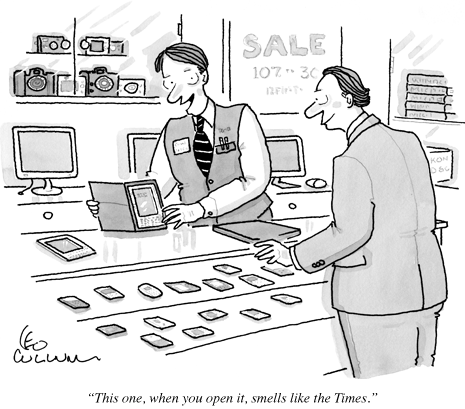A friend recently mentioned reading an article on The Atlantic magazine. The word “on” fell curiously on the ear as the expected phrasing would be “I read it in The Atlantic”. By “on” she obviously meant that she had read it on her tablet or smartphone, rather than reading it in the printed magazine.
The movement from paper and ink to screens and pixels has long been eliciting laments about the lost art of perusing a printed piece…the lost sensory experience of the way the pages feel to the touch…the smell of a newly printed book or of an old, musty one from a used bookstore.
But it’s useless to argue the superiority of one medium over the other. Each has, and will, find its place in people’s lives. E-books have been outselling hard copy books on Amazon for the last two years.
That’s not to say that the difference in media isn’t important. As Scott Maney wrote in a recent Communication Arts column (and yes, I read it in the print version of the magazine), “You didn’t just read the newspaper—you experienced it. The smell of the newsprint. The ink on your hands. The soft touch of the paper…The newspaper engulfed you.”
What he goes on to discuss is the multi-sensory effect of printed media that simply can’t be experienced on your shiny new Kindle Fire HD. While tablets and phones can create instantaneous opportunities for further exploration and even connections to other readers, they do not replace the multi-sensory immersion of reading a book or the Sunday New York Times.

Thus the words “in” and “on” communicate more than just the change of a single letter. These are different paradigms of media consumption. “On” has to do with surfing a surface; while “in” suggests an immersion into something—an enveloping media consumption experience.
Even the visual component of reading—common to both print and digital—happens differently on the two platforms. With print, the eyes rove the page, looking ahead and back like a reconnaissance aircraft over the terrain below it. An e-book or smartphone article entails a more linear reading experience.
And here why this should all matter to marketers: Great brands are built to engage multiple senses and create an experience, not just a transfer of information. The more senses you can engage the better. (Smell-O-Vision, where art thou?) The more your audience is immersed in a process of multi-sensory discovery rather than merely being fed information or entertainment, the more that their emotions can come into play—and that’s powerful stuff in the world of branding. That’s why great digital advertising tugs at the emotions, overcoming the distance created by pixels and screens. Dove’s Real Beauty Sketches is the quintessential example. The video is also filled with a multitude of textures: you can almost feel the subjects’ skin and the paper the artist is drawing on.
In a less serious vein, people’s need for sensory experience in a digital world was humorously reinforced in Google’s recent April Fool’s Day joke. Google Nose was launched claiming to offer a “15 million scentibyte database of smells from around the world.” Millions of iPad nose-prints later, the joke contained an important kernel of truth. People crave real experiences.
It’s why, despite how digital everything has become, the most common symbol for the digital communication tools we use are still so persistently analog: Email’s ubiquitous icon is a little paper envelope. Computer folder icons are manila folders. A new message icon is usually a notepad and a pen. The icon for saving a document is a little floppy disk. And attachment icons are always paper clips.
So while there is no turning back digital, it’s fascinating to see how creative marketers are finding ways to make things feel more experiential, more participatory and more emotionally engaging.
So keep it real, and we’ll smell ya later.